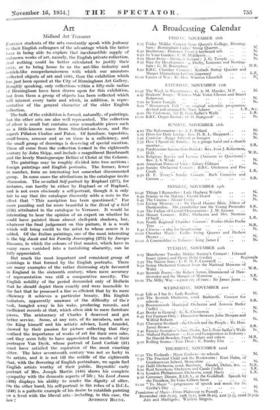Art
Midland Art Treasures
FOREIGN students of the arts constantly speak with jealousy to their English colleagues of the advantage which the latter have in being able to., explore that inexhaustible supply of
unknown works of art, namely, the English private collection.. And nothing. could be better calculated to justify their
envy, or to bring home to us the ant-like industry and ostrich-like comprehensiveness with which our ancestors collected objects of art and virtu, than the exhibition which has just been opened at the City of Birmingham Art Gallery. Roughly speaking, only collections within a fifty-mile radius of Birmingham have been drawn upon for this exhibition, but from them a group of objects has been collected which will interest every taste and which, in addition, is repre- sentative of the general character of the older English collection.
The bulk of the exhibition is formed, naturally, of paintings, but the other arts are also well represented. The collection of silver is small but contains sonic remarkable pieces such as a little-known mace from Stratford-on-Avon, and the superb F'illaton Chalice and paten. Of furniture, tapestries, snuff-boxes, armour and so on there is a sufficiency, and the small group of drawings is deserving of special mention. These all come from the collection formed in the eighteenth century by John Skipp, and include a magnificent Rembrandt and the lovely Mantegnesque Bellini of Christ at the Column.
The .paintings may be roughly divided into two sections :. foreign paintings and English portraits. The former, fewer in number, form an interesting but somewhat disconnected group. In some eases the attributions in the catalogue invite discussion. The so-called Self-portrait by Raphael (277), for instance, can hardly be either by Raphael or of Raphael, and is not even obviously a self-portrait, though it is only fair to say that the catalogue discreetly adds a note to the effect that " This ascription has been questioned." Far more puzzling and far more beautiful is the Head of a Girl (150). attributed in the catalogue to Vermeer. It would be interesting to hear the opinion of an expert on whether he could have painted. those almost shell-pink shadows, but, whatever the final judgement on this picture, it is a work which will bring credit to the artist to whose oeuvre it is added. Of the Italian paintings, one of the most interesting is the big Jacob and his Family Journeying. (275) by Jacopo Bassano, in which the colours of that master, which have in many cases vanished into a tantalizing obscurity, can be fully appreciated.
But much the most important and consistent group of paintings is that formed by the English portraits. There are many examples of the rather distressing style favoured in England in the sixteenth century, when mere accuracy of representation was still a comparative novelty. The English nobility of the period demanded only of Holbein that he should depict them exactly and were insensible to the fact that he possessed a line so efficient that by its mere efficiency it achieves a particular beauty. His English imitators, apparently unaware of the difficulty of their task, bungled away in his wake, producing records, and inefficient records at that, which often sink to mere furniture pieces. The aristocracy of Charles I deserved and got better service. Some, at any rate, of its members, such as the King himself and his artistic adviser, Lord Arundel, showed by their passion for picture collecting that they realized the importance of works of art for their own sake, and they seem fully to have appreciated the merits of their portrayer Van Dyck, whose portrait of Lord Carlisle (21) must have satisfied the aspiration of the. most exacting. sitter. The later seventeenth century -was not so lucky in its artists, and it is not till the middle of the eighteenth that, with the flowering of English portraiture, we again find English artists worthy of their public. Reynolds' early portrait, of Mrs. Joseph Martin (446) shows his complete sympathy with the domestic aspects of life ; his Lord Anson (436) displays his ability to render the dignity of office. On the other hand, his self-portrait in the robes of a D.C.L. (248) is a pathetic example of his desire to establish painting on a level with the liberal arts-including, in this case, the






































 Previous page
Previous page